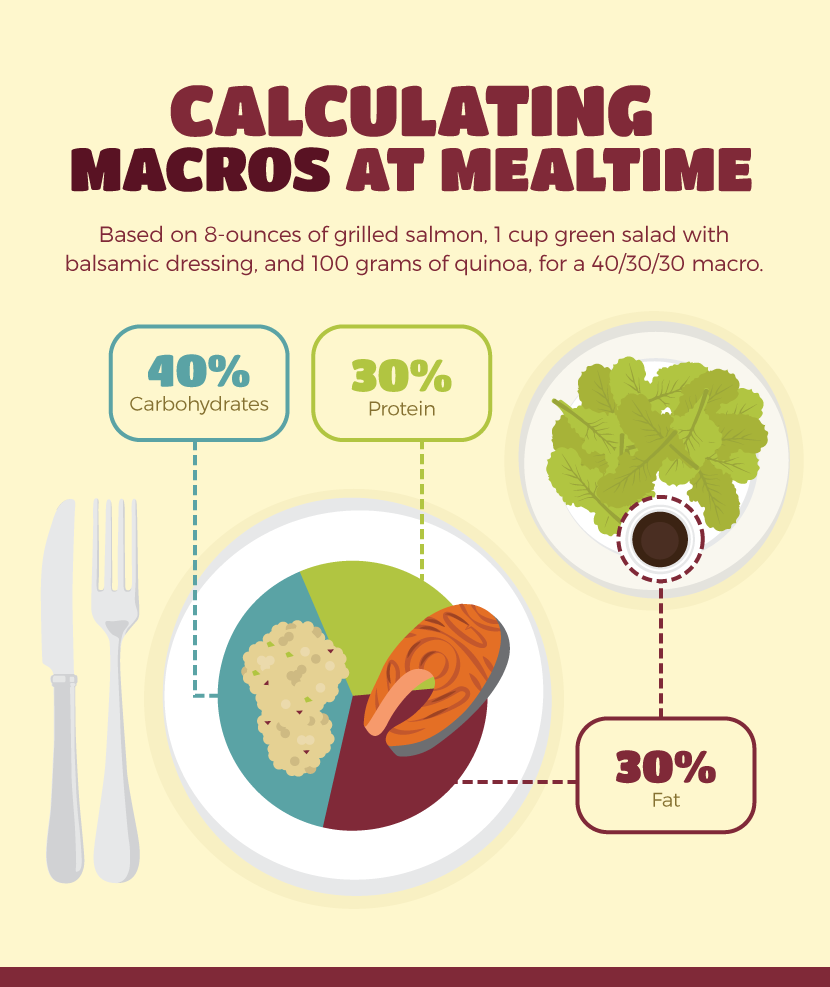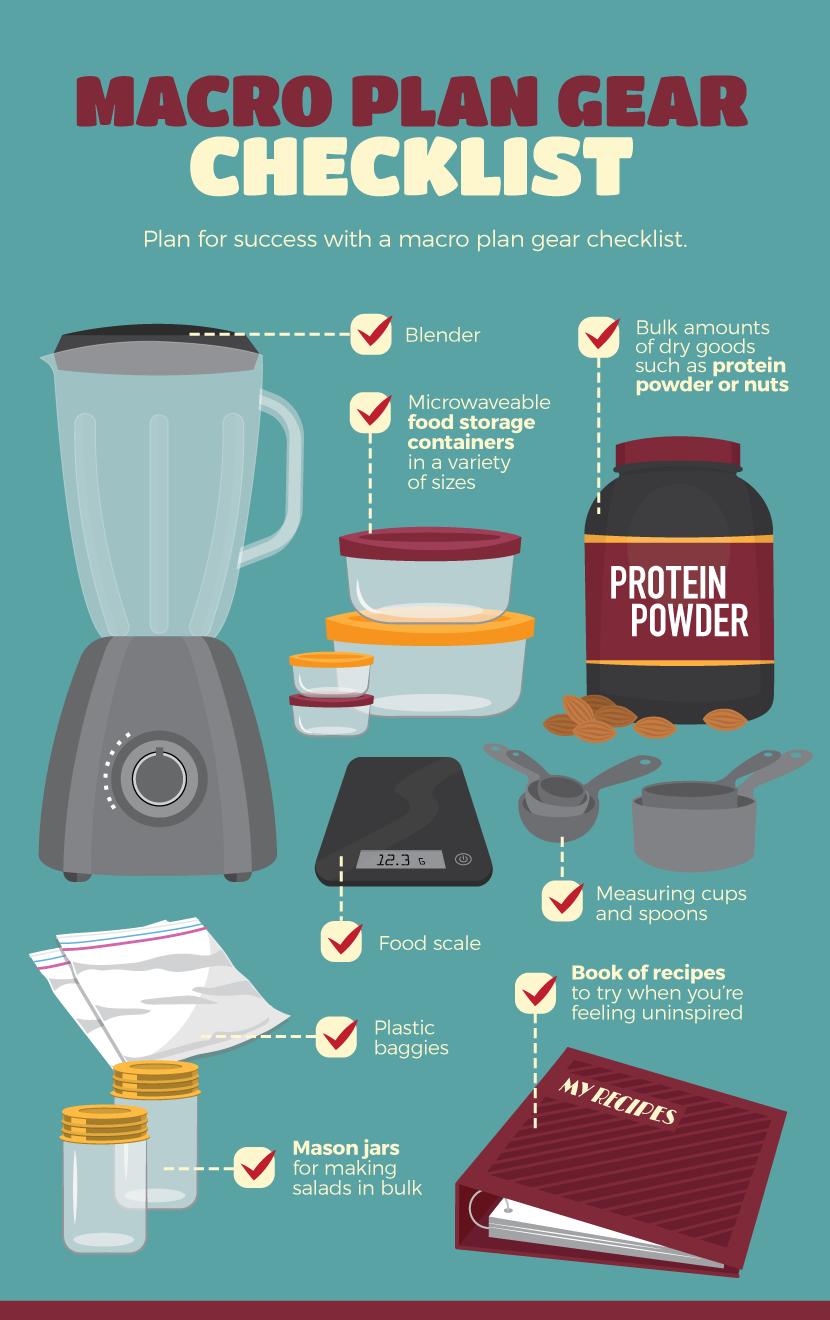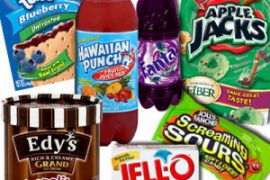The concept of macros, also called IIFYM (If It Fits Your Macros), is to consider your nutrition as food comprised of proteins, carbohydrates, and fats that combine together to build a highly personalized plan. Instead of losing yourself in the details of micronutrients, such as whether you are getting enough potassium or magnesium, the focus is on the macro building blocks of our diet.
This plan is specific to your goals and needs and can be modified depending on your progress or changes in your objectives. Although there are no hard and fast rules about the percentages to use for your individual base calculations, many sources look at several factors. Are you just trying to eat well or are you trying lose fat, build muscle, or take part in a fitness or bodybuilding competition? All of these variables will slightly sway the needle in one direction or the other, but for this discussion we are going to use the most common percentages recommended by most macro enthusiasts: 40 percent carbohydrates, 30 percent fat, and 30 percent protein.
If you are a hardcore CrossFitter or a fitness competitor, I recommend using a macro calculator to come up with your own personalized plan. This calculator will take into account your body type, gender, current weight and fitness goals to calculate specific macros based on the data. For the rest of us, using the 40/30/30 breakdown is a good starting point.
Macros Basics
Something you need to know going into a launch of the macros program in your household is that you will be doing a lot of math. You will weigh food and convert grams to calories and calories to grams. At first it can seem overwhelming, but as you practice you will streamline the process and it will seem less obtrusive in your day. But, for sure, this food plan requires commitment and attention to detail.
The most basic piece of the program you need to know is that one gram of protein is worth four calories. One gram of carbohydrates is also worth four calories, but each gram of fat is worth nine calories. You can see why fats sustain us so much better than carbs or even proteins! They have more “fire to burn.”
Once you get comfortable with the basic calculations, you need to have a grasp of how many calories a day you want to eat. Interestingly, the Macro Gods leave this largely up to us based on our personal needs. However, for a little assistance in that decision, use this chart to guide you to the total calories you should be eating per day based your specific goals.
Another thing you need to understand about nutrition in general is that no food is purely a carbohydrate, a fat, or a protein. A six-ounce piece of grilled salmon, for instance, is 40 percent fat, 60 percent protein, and has no carbohydrates, whereas one-half cup of brown rice is 84 percent carbohydrate and has 8 percent fat and 8 percent protein. So when you calculate your 40/30/30, you have to take into account that every food is a blend of fats, carbohydrates, and proteins.
When embarking on a macros program, observe your ratios plate by plate. For example, a four-ounce breast of chicken, two-thirds of a cup of brown rice, and 24 grams of almonds add up to a 40/30/30 meal. Another example might be eight ounces of grilled salmon, one cup of green salad with balsamic dressing, and 100 grams of quinoa. You can see where the math comes into play here! There are some helpful macro food calculators available but I prefer to use MyFitnessPal. It is a free and user-friendly app with a macros function that you can use to look at one food item, a meal, or a whole day.
What Should You Eat on the Macros Plan?
One of the downfalls of this program is the lack of attention to quality of food. Many enthusiasts adhere to the mantra that “if it fits your macros, then you can eat it.” Can you eat a burger or fries? Sure, “if it fits your macros.” But I challenge you to make better choices. If your protein source is a choice between a burger or salmon, you know what the right decision is. Also, I recommend keeping some snacks on hand that are what Nicole from www.fitfulfocus.com calls “macro-magnanimous” foods. She refers to them that way because you might find yourself at the end of the day with calories to eat but out of one macro or another. You should always have some go-to snacks that are largely one macro. Remember – hardly any food is entirely one macro, but you can get close. An example would be egg whites for protein or sweet potatoes for primarily carbohydrates. I have provided you with some quality options for your 40/30/30 macro meals below. But first, some tips for macro meal preparation success.
Tips for Macro Meal Preparation Success
Pre-prep is king: If you don’t spend some time pre-portioning your food for the week, you will encounter a lot of last-minute panic to make sure you are accurate. Pre-weighing ten breasts of chicken is much faster than individually weighing them at each meal. You can also make up your salad dressings, hard boil eggs, or put whole meals into one container to grab and go.
Check your social calendar each week and strategize: Don’t be caught off-guard in a restaurant ordering “off plan” or not ordering at all because you failed to foresee an issue with being able to “fit your macros.”
Buy a good-quality scale: The better your tools, the better your success.
Download a macros app: Make sure you have a great macros app for recording your food and checking food macros.
Record: Make sure to record your food everyday. This makes the process infinitely easier as you continue to execute the program because you can look back and simply use data from food you have already eaten. Also, all successful people know that if you don’t record the data and your goals, your rate of success plummets.
Breakfast
Low-Sugar Smoothie: 2 cups spinach, ¼ of a cucumber, ½ cup frozen raspberries, 2 leaves swiss chard, 1 tsp ginger, 1 lemon – juiced, 1 tsp fish oil, 1 scoop protein powder.
Bacon and Eggs: 2-egg egg white omelet with spinach and mushroom, two pieces of turkey bacon, and two pieces of whole wheat toast, no butter.
Lunch
Chicken Salad: 2 cups greens, 2 tbsp balsamic dressing, 4-ounce grilled chicken breast, and 30 grams (13) seed crackers.
Turkey Pita Pocket: ½ pita pocket, lettuce, shredded carrot, cucumbers, 180 grams deli turkey, 1 tbsp mayonnaise.
Dinner
Bison Burger with Grilled Veggies: 6-ounce bison burger with bun and grilled carrots, asparagus, and mushrooms.
Grilled Salmon: Grilled 6-ounce salmon, brown rice, and side salad.
If you’re eating out, keep an eye on this list of fast food options near the 40/30/30 ratio to help you stay on plan.
The macros eating plan is a great fit for many who have specific nutrition goals in mind. My closing recommendations for macros meal planning are as follows:
- Write out next week’s meals and snacks ahead of time.
- Shop and prep beforehand as much as possible. You will be so grateful when you are starving to have some go-to foods in the fridge that can keep you on plan.
- Keep a personal recipe book with five to seven meals that you have tried and liked, and meet your 40/30/30 requirements.
- Make sure to have acceptable 40/30/30 snacks on hand at all times.
- It is better to keep each meal at 40/30/30 than trying to maintain balance across a whole day. Adhere to this as closely as possible.
After a couple weeks of macro meals, your execution will be come more effortless. Once you learn to eyeball specific weights and measurements, you will be able to put aside your scale and measuring cups more often. The goals you have set for yourself from a nutrition and fitness perspective will be better achieved by your consistent and dedicated approach to your nutrition.
 About the author:
About the author:
Dr. Heather is a seasoned chiropractor with specializations in pediatrics, pregnancy, and a certification in wellness chiropractic (CCWP). She is an avid athlete, health enthusiast and writer who has a passion for inspiring people of all ages to take first steps toward realizing their greatness within. She is the author of The Three Day Reset, a totally doable food plan that anyone can do and see results.
Through online content, public speaking and coaching, Heather shares wellness, fitness, and nutrition expertise for those looking for deeper change. For further information, she can always be found at her blog WELLFITandFED.com.
Reprinted with permission from our friends at Fix.com/blog
Resources:
- http://www.bodybuilding.com/content/to-macro-or-not-should-you-track-your-macro-intake.html
- http://www.formulazone.com/sampledinnerrecipe.asp
- https://recipes.sparkpeople.com/home.asp
- http://www.iifym.com/what-is-iifym/
- http://www.bodybuilding.com/content/from-here-to-macros-4-steps-to-better-nutrition.html
- https://www.washingtonpost.com/lifestyle/wellness/the-macros-diet-does-it-really-work/2016/06/07/d38a5434-2bf6-11e6-9b37-42985f6a265c_story.html











